This article was medically reviewed by Lacy Windham, MD. Lacy Windham, MD, is a Board-Certified Obstetrician & Gynecologist in Cleveland, Tennessee. Dr. Windham attended medical school at the University of Tennessee Health Science Center in Memphis. Her residency was completed at Eastern Virginia Medical School in Norfolk, Virginia. She was the recipient of multiple awards during her residency training, including Most Outstanding Resident in Maternal Fetal Medicine, Most Outstanding Resident in Oncology, Most Outstanding Resident Overall, and Special Award in Minimally Invasive Surgery.
This article has been viewed 172,601 times.
Experts say that anal fissures may cause pain when you have a bowel movement, itching around your anus, and bleeding from your anus. While these symptoms can be scary and may cause a lot of discomfort, it's very common to have anal fissures after you have a baby or during pregnancy. Anal fissures are tiny tears in your rectal lining that can take weeks to heal. Research suggests that anal fissures typically heal after 4 to 6 weeks of home care, but call your doctor if they aren't improving or you're worried about your pain or bleeding.[1]
Steps
Using Home Remedies
-
1Take hot sitz baths. A sitz bath is a warm water bath in which you sit upright in the bath in order to heal or clean the rectal area.[2]
- Try to take a sitz bath after bowel movements. This cleans the anus without irritating it with toilet paper, allows spasms to relax, and increases blood flow to the anus.
- You can take a sitz bath by purchasing a special sitz bath seat. Your doctor may provide you with one if you tell her about the issues you're having with anal fissures. You can also purchase one at a medical supply store.
- Attach the sitz bath seat to your toilet and fill it with warm water. Make sure the water is not warm enough to cause pain by testing it with your finger or hand first.
- Most sitz baths have vents that allow water to drain out on occasion. If your bath does not have a vent, change the water periodically to keep it fresh and at a warm temperature.
- You should remain seated in your bath for 10 to 20 minutes. Try to sit still during that time, avoiding sudden movements that could prevent relaxation.
-
2Eat a high fiber diet. A high fiber diet can encourage regular bowel movements. A high-fiber diet results in softer stool that are passed faster. This can help anal fissures heal.[3]
- The National Academy of Sciences Institute of Medicine recommends women get 21 to 25 grams of fiber a day, depending on age. On average, most Americans only get 5 to 14.
- High fibers foods include fruits, such as berries, apples, oranges, raisins, figs, and pears. They also include whole wheat grains, such as whole-wheat pasta and bread, and breakfast foods like oatmeal, bran muffins, and bran flakes. Broccoli, green peas, potatoes, and brussels sprouts are good vegetable options. Certain nuts and legumes are high fiber, such as black beans, lima beans, and baked beans, as well as a variety of seeds.
- However, make sure your fiber intake is not comprised of too many foods that could prove difficult to digest. Avoid nuts, popcorn, tortilla chips, and other hard foods with sharp edges.
Advertisement -
3Increase your fluid intake. Soft stools can ease the pain of anal fissures and allow the rectum to heal. Increasing your fluid intake can help soften your stools.[4]
- Aim to get enough water a day. Only drink water with meals rather than juice, soda, or other beverages.
- Take a water bottle with you when you go out and sip on it when you get thirsty.
-
4Exercise. Regular exercise can help reduce anal fissures as it prevents constipation, which can aggravate existing fissures. Strive for 30 minutes of physical activity most days of the week. Talk to your doctor about what types of physical activity are safe for you after childbirth. It varies depending on your delivery. Your doctor should be able to provide you with a list of safe exercises.
Seeking Medical Help
-
1Try topical anesthetics and steroids. Topical anesthetics, used in conjunction with steroid cream, can be used before a bowel movement to reduce pain caused by anal fissures.[5]
- Xylocaine, lidocaine, tetracaine, and pramoxine are topical anesthetics. While some anesthetics are available over the counter, many require a prescription. Ask your doctor for a recommendation and, if needed, a prescription for an anesthetic to treat your anal fissures.
- Creams are applied gently on the rectal region before a bowel movement, with a clean paper towel or wipe. Some drug stores sell wipes specifically designed for applying such creams.
- A small amount of a steroid is often combined with creams and ointments. This helps reduce inflammation and numb some of the pain associated with bowel movements.
- If using steroids alongside aesthetics, you should not use the medication for more than 2 weeks. Using steroids for a longer period can thin parts of the rectum, resulting in further trauma to the area.
-
2Use stool softeners. Your physician should be able to recommend a stool softener for you. This will help ease the pain and labor involved during bowel movements, giving fissures a chance to heal.[6]
- While stool softeners are generally available over the counter, you should ask your physician for a recommendation. If you are breastfeeding especially, you want to find a brand of softener that will not harm your baby.
- Take stool softeners as directed on the medication's label. Only take the suggested dosage and be aware of any possible side effects. Talk to your physician if you experience any side effects.
- Combing stool softeners with home remedies, like drinking extra fluids and eating a high fiber diet, can help with anal fissures.
-
3Ask your doctor about nitroglycerin. Some ointments contain a muscle relaxant called nitroglycerin. Nitroglycerin can relax the sphincter muscles and reduce contractions and spams during bowel movements, and also help increase blood flow to the anus. This reduces the trauma around the rectal region, giving anal fissures the chance to heal.[7]
- Nitroglycerin should be applied using a q-tip. Apply a small amount of ointment to the q-tip and insert the cotton tip into the anus. Do not go farther than this, only inserting the cotton portion.
- The concentration of nitroglycerin in ointments is relatively low, usually only around 0.2%. Topical use of nitroglycerin for treating anal fissures is considered safe while breastfeeding.
- Side effects do occasionally occur when using nitroglycerin. The most common side effect is a headache or lightheadedness.
Having Surgery
-
1Know why surgery might be needed. Most anal fissures heal on their own with 4 to 6 weeks. If your anal fissures does not heal within this timeframe, and does not seem to improve with use of medication, your doctor might recommend surgery.[8]
- The standard surgery to treat an anal fissures involves cutting a portion of the sphincter muscle. This helps relax the bowels, helping the fissure heal.
- Surgery has a high success rate, with over 90% of fissures clearing up after the procedure
-
2Prepare for your surgery. Your doctor will talk to you about how to prepare for your surgery. Follow all her instructions and do not hesitate to ask any questions if something confuses you.
- You will probably be asked not to eat or drink anything after midnight the day before your surgery.
- Your doctor will tell you what medications you should and should not take prior to the operation, including any herbal supplements or over the counter sleep aids.
- Bowel prep is common in anal fissure surgery. You may be given an enema or laxatives prior to the operation.
-
3Recover from surgery. Anal fissure surgery is a same day procedure. This means, assuming there are no complications, you will leave the hospital the same day you had the procedure done. Your doctor will give you instructions on how to recover from the operation.[9]
- Normal activity can be resumed shortly after surgery, but it should be gradual. Make sure you walk the night after surgery, as this lessens the risk of blood clots, which can be potentially life threatening.
- Depending on the type of surgery, you should not return to work for 1 to 4 weeks. Avoid driving until you're done taking pain medications.
- Your surgery will leave a wound in the rectal area that needs treatment. Keep the wound clean and dry and take sitz baths baths 3 times a day. Bloody drainage will occur for a few days following the surgery, so the wound should be sealed with gauze.
Warnings
- If bleeding is more than a small amount that is bright red in color, consult your doctor to see if you have a more serious problem. Anything more than a few spots of bright red blood could signal a bigger problem.⧼thumbs_response⧽
References
- ↑ https://www.uofmhealth.org/health-library/uf4764
- ↑ https://my.clevelandclinic.org/health/diseases/13177-anal-fissures
- ↑ https://www.ucsfhealth.org/education/anal-fissures
- ↑ https://www.ucsfhealth.org/education/anal-fissures
- ↑ https://www.nhs.uk/conditions/anal-fissure/treatment/
- ↑ https://www.hopkinsmedicine.org/health/conditions-and-diseases/anal-fissures
- ↑ https://my.clevelandclinic.org/health/diseases/13177-anal-fissures
- ↑ https://www.nhs.uk/conditions/anal-fissure/treatment/
- ↑ https://myhealth.alberta.ca/Health/aftercareinformation/pages/conditions.aspx?hwid=ud1292
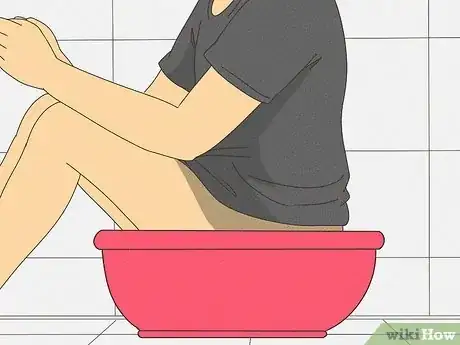



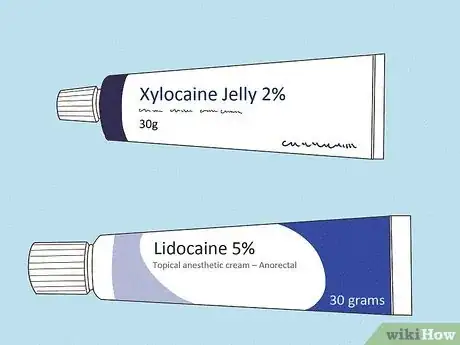
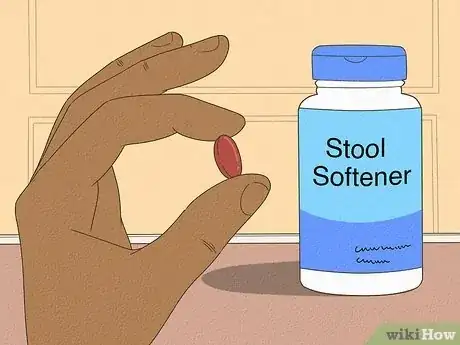

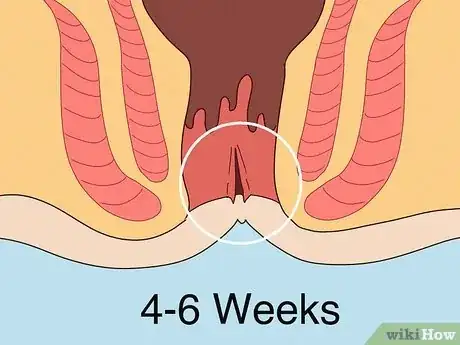








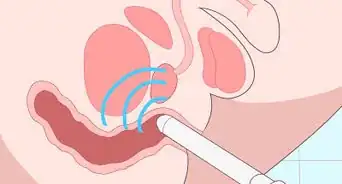

















































Medical Disclaimer
The content of this article is not intended to be a substitute for professional medical advice, examination, diagnosis, or treatment. You should always contact your doctor or other qualified healthcare professional before starting, changing, or stopping any kind of health treatment.
Read More...